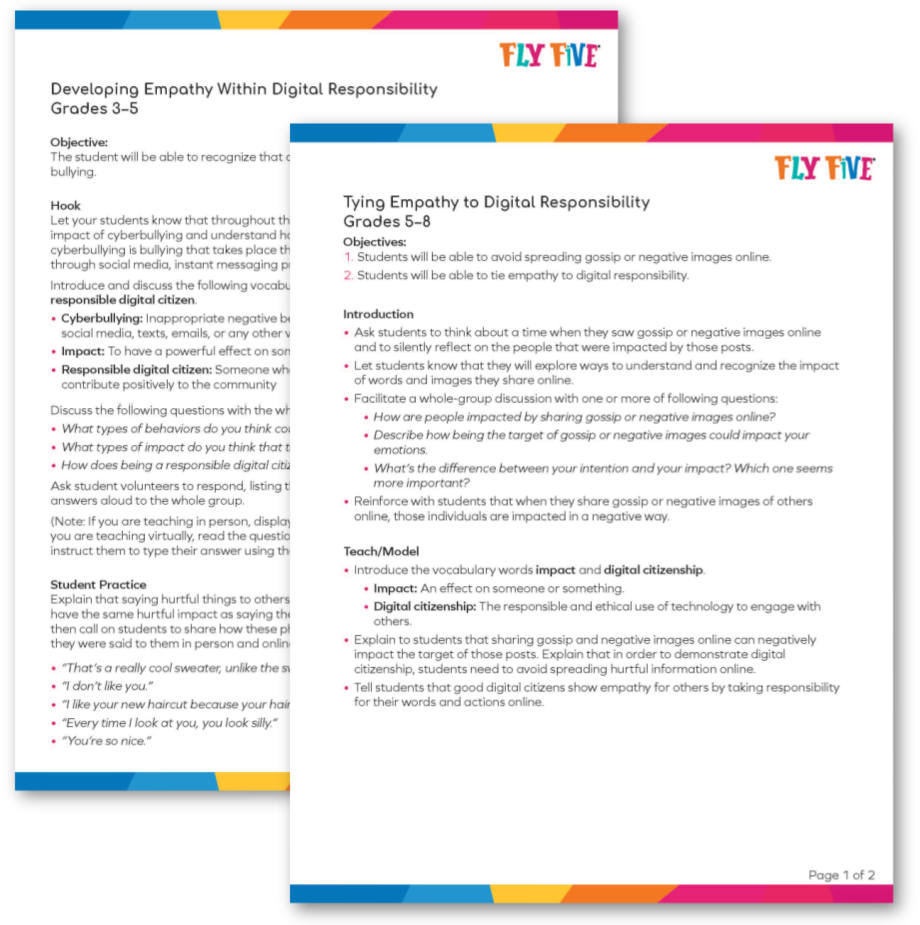From an early age, children learn the basics of good citizenship from parents and teachers. They are taught the fundamentals, including good manners, taking turns, using kind words, caring for others, sharing, and respecting cultural norms. Since the advent of the Internet, though, a new aspect of citizenship has emerged: Social media. Existing outside the physical spaces of our home, school, and work, social media platforms have become places where children and adults alike find friends, construct virtual communities, explore new interests, and stay in touch with family and friends. We are now, to an extent, citizens of two
different worlds that are both interconnected and interdependent (Carrier et al., 2013).
Children are entering this virtual world at the same time that they begin a critical stage in their social and emotional development (Hinduja & Patchin, 2020). Social media platforms can have great benefits for some children, such as those who struggle to find friends in their schools and community, and who are able to successfully leverage this broader platform to reach others with similar interests.
But social media can also have negative impacts on children. Unsupervised access to the Internet and social media can expose children to content that is inappropriate for their age. In addition, the consequences of cyberbullying can be devastating for both adults and children. The negative impacts of social media can be even more harmful than conflicts encountered at school because children tethered to their smartphones feel like they can’t get away from it (Martin et al., 2018).
In a study on smartphone use among teens, a Common Sense Census found that the average U.S. child between the ages of 8 and 12 spent nearly five hours per day online (Rideout & Robb, 2019). Between their online activities and school, children in this age group are connected to their social circle, for better or for worse, the majority of their waking hours. A fear of missing out on something keeps children glued to these virtual interactions, even when these interactions could be harmful to the child’s mental health.
Why Should Children Learn About Digital Responsibility?
Digital responsibility is a key competency that must be promoted in school and at home. Too often children are only taught how to log on and navigate the Internet. Teachers and parents must be involved in the online activities of students in order to teach children how to stay safe online, how to communicate effectively when using social media, and how to distinguish what is appropriate behavior when online (Kim & Choi, 2018).
The prevalence of cyberbullying makes digital responsibility even more important. Cyberbullying is defined as the use of technology to threaten, harass, denigrate, humiliate, or spread rumors about others (Hinduja & Patchin, 2020). Bullying is not a new phenomenon and has occurred among children for generations. The difference today, of course, is that bullying can now follow a child home by way of social media. Preteens and teens, deep in the social gauntlet of adolescence, can be particularly cruel to their peers, especially if they have not learned how to be responsible and best manage interactions online.
Digital responsibility requires an understanding of how the impacts of cyberbullying and online harassment can be just as devastating as they would be in person. Casual cruelty can be emboldened by physical distance and anonymity. Teaching children digital responsibility gives them a roadmap for what is appropriate behavior online and how to respond to inappropriate behavior. Children need to understand that the way that we behave online has consequences in the real world of face-to-face interactions (Hinduja & Patchin, 2020).
Tying Empathy to Digital Responsibility
A study by Pfeil and Zaphiris (2007) found that social conventions and values such as kindness, fairness, candor, and empathy were just as important online as they were in person. As children establish an online presence, it is imperative that teachers and parents treat empathy as a crucial aspect of digital citizenship. Specifically, children should be taught:
- The importance of empathy when dealing with others, both online and in person
- How to identify and react to hate speech, cyberbullying, and other forms of abuse
- How to be a good digital citizen (Carrier et al., 2015)
Empathy creates a desire to make the world a better place and empowers students to know what is right and how to stand up for what is right. Teaching children to be empathetic in their interactions with others will prepare them to be ethical, conscientious citizens both in-person and online (Kim & Choi, 2018). By learning digital responsibility, students will understand how to recognize cyberbullying and the impacts this abuse can have on others. Because they have learned how to have empathy for others, students are less likely to become abusers themselves.
Download these ready-to-use lessons for teaching your students to be aware of the impact their actions have on others online.

References
- Carrier, L. M., Spradlin, A., Bunce, J. P., & Rosen, L. D. (2015). Virtual empathy: Positive and negative impacts of going online upon empathy in young adults. Computers in Human Behavior, 52(November), 39–48. https://doi.org/10.1016/j.chb.2015.05.026
- Hinduja, S., & Patchin, J. W. (2020). Cyberbullying fact sheet: Identification, prevention, and response. Cyberbullying Research Center (cyberbullying.org). https://cyberbullying.org/Cyberbullying-Identification-Prevention-Response-2020.pdf
- Kim, M., & Choi, D. (2018). Development of youth digital citizenship scale and implication for educational setting. Journal of Educational Technology and Society, 21(1), 155–171. http://www.jstor.org/stable/26273877
- Martin, F., Wang, C., Petty, T., Wang, W., & Wilkins, P. (2018). Middle school students’ social media use. Journal of Educational Technology and Society, 21(1), 213–224. http://www.jstor.org/stable/26273881
- Pfeil, U., & Zaphiris, P. (2007). Patterns of empathy in online communication. CHI ’07: Proceedings of the SIGCHI Conference on Human Factors in Computing Systems. Association for Computing Machinery. https://dl.acm.org/doi/10.1145/1240624.1240763
- Rideout, V., & Robb, M. B. (2019). The Common Sense census: Media use by tweens and teens, 2019 Common Sense Media. https://www.commonsensemedia.org/sites/default/files/uploads/research/2019-census-8-to-18-key-findings-updated.pdf
